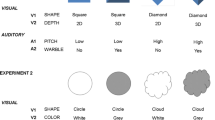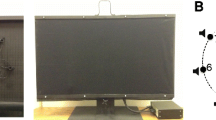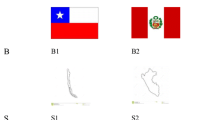Abstract
Two experiments investigated equivalence relations among auditory, visual, and tactile stimuli. In Experiment 1, three 6- and 7-year-old children learned conditional discriminations with auditory samples and tactile comparisons. In subsequent tests, they demonstrated that the conditional relations of the auditory and tactile stimuli were equivalence relations. Through cross-modal transfer, the classes also had extended to include novel visual stimuli that resembled the tactile stimuli in form and size. Experiment 2 reversed the role of the tactile and visual stimuli. After learning conditional discriminations with auditory samples and visual comparisons, the children demonstrated equivalence classes that included the training stimuli plus novel tactile stimuli that resembled the visual stimuli. One child in this experiment needed cross-modal training before the classes appeared. The experiments illustrate one way in which stimulus equivalence classes are extended and relate the paradigm of stimulus equivalence to studying perception.
Similar content being viewed by others
References
BUSH, K. M., SIDMAN, M., & DEROSE, T. (1989). Contextual control of emergent equivalence relations. Journal of the Experimental Analysis of Behavior, 51, 29–45.
CAIRNS, S. E., & COLL, P. (1977). The role of visual imagery in visual, tactual and cross-modal matching. British Journal of Psychology, 68, 213–214.
COSTALL, A. P. (1984). Are theories of perception necessary?: A review of Gibson’s The ecological approach to visual perception. Journal of the.Experimental Analysis of Behavior, 41, 109–115.
COTÉ, J. J., & SCHAEFER, E. G. (1981). Perceptual processing strategies in the cross-modal transfer of form discrimination: A developmental study. Journal of Experimental Psychology: Human Perception and Performance, 7, 1340–1348.
DUBE, W. V., MCILVANE, W. J., MACKAY, H. A., & STODDARD, L. T. Stimulus class membership established via stimulus-reinforcer relations. Journal of the Experimental Analysis of behavior, 47, 159–175.
ETTLINGER, G. (1977). In A. M. Schrier (Ed.), Behavioral primatology: Advances in research and theory, Vol. 1. Hillsdale, NJ: Erlbaum.
FIELDS, L., REEVE, K. F., ADAMS, B. J., & VERHAVE, T. (1991). Stimulus generalization and equivalence classes: A model for natural categories. Journal of the Experimental Analysis of Behavior, 55, 305–312.
GIBSON, J. J. (1979). The ecological approach to visual perception. Boston: Houghton Mifflin.
GREEN, G. (1990). Differences in development of visual and auditory-visual equivalence relations. American Journal on Mental Retardation, 95, 260–270.
LAZAR, R. M. (1977). Extending sequence-class membership with matching to sample. Journal of the Experimental Analysis of Behavior, 27, 381–392.
LAZAR, R. M., & KOTLARCHYK, B. J. (1986). Second-order control of sequence-class equivalences in children. Journal of the Experimental Analysis of Behavior, 13, 205–215.
LOBB, H. (1970). Asymmetrical transfer of form discrimination across sensory modalities in human adults. Journal of Experimental Psychology, 86, 350–354.
LYNCH, D. C., & GREEN, G. (1991). Development and crossmodal transfer of contextual control of emergent stimulus relations. Journal of the Experimental Analysis of Behavior, 56, 139–154.
MOLANDER, B., & GARVILL, J. (1979). The invariance of asymmetric cross-modal transfer effects. Scandinavian Journal of Psychology, 20, 171–177.
RABINOWITZ, R. M. (1983). Cross-modal transfer and intermediate-size transposition. Journal of Experimental Child Psychology, 35, 223–235.
SIDMAN, M. (1971). Reading and auditory-visual equivalences. Journal of Speech and Hearing Research, 14, 5–13.
SIDMAN, M. (1990). Equivalence relations: Where do they come from? In D. R. Blackman & H. Lejeune (Eds.), Behavior analysis in theory and practice: Contributions and controversies (pp. 93–114). Hillsdale, NJ: Erlbaum.
SIDMAN, M., & CRESSON, O. (1973). Reading and crossmodal transfer of stimulus equivalences in severe retardation. American Journal of Mental Deficiency, 77, 515–523.
SIDMAN, M., CRESSON, O., Jr., & WILLSON-MORRIS, M. (1974). Acquisition of matching to sample via mediated transfer. Journal of the Experimental Analysis of Behavior, 22, 261–273.
SIDMAN, M., & TAILBY, W. (1982). Conditional discrimination vs. matching to sample: An expansion of the testing paradigm. Journal of the Experimental Analysis of Behavior, 37, 5–22.
SOLSO, R. L., & RAYNIS, S. A. (1982). Transfer of prototypes based on visual, tactual, and kinesthetic exemplars. American Journal of Psychology, 95, 13–29.
WETHERBY, B., KARLAN, G. R., & SPRADLIN, J. E. (1983). The development of derived stimulus relations through training in arbitrary-matching sequences. Journal of the Experimental Analysis of Behavior, 40, 69–78.
Author information
Authors and Affiliations
Additional information
This research was supported by Grant No. HD20688 from the NICHHD of the National Institutes of Health to Washington and Jefferson College.
Rights and permissions
About this article
Cite this article
Bush, K.M. Stimulus Equivalence and Cross-Modal Transfer. Psychol Rec 43, 567–584 (1993). https://doi.org/10.1007/BF03395900
Published:
Issue Date:
DOI: https://doi.org/10.1007/BF03395900




